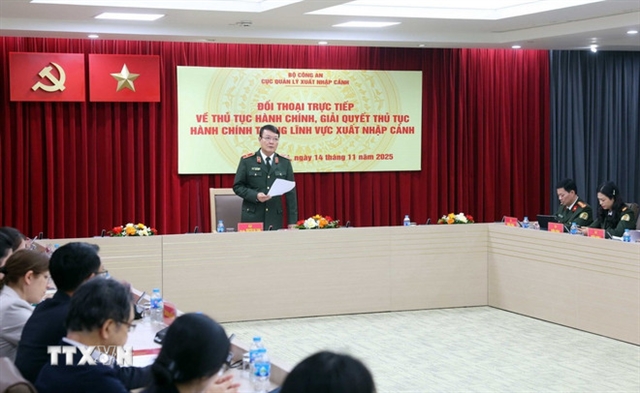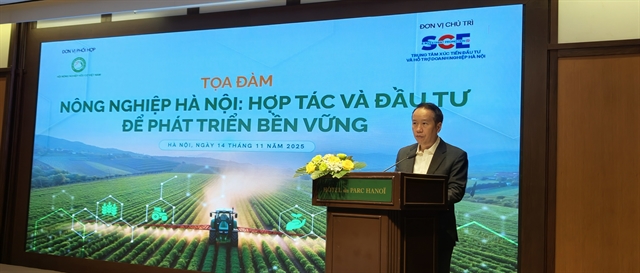 Society
Society

 |
| A worker of Hà Nội Sewerage and Drainage Company cleans up a street after the rain. VNS Photo Khánh Dương |
HÀ NỘI — Every rainy season, images of Hà Nội’s streets submerged under water have become a familiar and haunting sight for the capital’s residents.
As the 2025 storm season approaches, Hà Nội still has to struggle with urban flooding and how to build a resilient and flood-proof capital.
But what measures has the city implemented to cope, and are there any new advancements towards building a resilient and flood-proof capital?
Each time the storm season arrives, many inner-city areas experience flooding, with some places suffering from widespread inundation.
These flooded spots are typically in low-lying areas, underpasses and streets such as Nguyễn Chính, Hoa Bằng, Minh Khai, Thụy Khuê, Nguyễn Khuyến, Phan Bội Châu - Lý Thường Kiệt, Ngọc Lâm, and Thăng Long Boulevard.
The city’s current drainage infrastructure can only handle rainfall of about 50mm over two hours, while recent storms tend to bring more intense rain over shorter periods.
Rapid urbanisation has led to the filling in of lakes, ponds, canals, and the concreting of land surfaces, reducing the soil’s ability to absorb water and disrupting natural water flow, resulting in more frequent flash flooding.
Experts note that although efforts have been made to upgrade the drainage system, the infrastructure still struggles to handle increasingly unpredictable heavy rainfalls, leading to persistent flooding in many areas.
This is not a challenge unique to Hà Nội but one shared by major urban centres worldwide.
The consequences of flooding extend beyond traffic disruption. They include environmental contamination from sewage overflows, public health risks and interruptions to economic activity, particularly in inner-city areas.
Meteorological experts forecast that 2025 will see complicated weather patterns, with two to three storms and three to five flood events, some of which could be unusually strong and unpredictable.
.jpg) |
| Water drainage workers use a pumping truck after a flooding in Hà Nội. VNA/VNS Photo Nguyễn Thắng |
Associate Professor Mai Văn Khiêm, director of the National Centre for Hydro-Meteorological Forecasting, said: “The 2025 storm season may not be as extreme as during strong El Nino–Southern Oscillation years, but the unpredictability in trajectory and intensity will be a major challenge for forecasting and response.”
This climate uncertainty, coupled with Hà Nội’s limited flood control and dike infrastructure, poses significant challenges, he said.
Though five critical points along the city’s river dikes have been identified, comprehensive repairs and upgrades are still incomplete, he said.
According to a representative of Hà Nội Sewerage and Drainage Company, about 2,000 staff are on duty around the clock during the rainy season to operate pumping stations and regulate retention lakes at full capacity.
However, many drains remain clogged with garbage and sediment.
Even though the sewers are regularly cleared, a single heavy downpour can bring a deluge of waste from residential areas, causing blockages, Kinh Tế & Đô Thị (Economic & Urban Affairs) newspaper reported.
A major obstacle in flood prevention is financial and human resource limitations. Key infrastructure projects like upgrading Đông Mỹ pumping station, dredging the Nhuệ River, or constructing the Liên Mạc drainage hub, require billions of đồng in investment, which exceeds the city’s budget.
“Whenever there’s heavy rain, our company is stretched to the limit. All staff must be mobilised to flood-prone locations. But even with maximum effort, we still need a significantly larger workforce,” the representative said.
Optimal solutions
According to Kinh tế & Đô Thị reporters, Hà Nội has made progress in seeking sustainable anti-flooding solutions in recent years.
On the infrastructure side, the city is building retention lakes in Thanh Xuân and Long Biên districts to ease the burden on drainage systems and create ecological spaces.
Projects to improve the Tô Lịch and Nhuệ river basins, and pumping stations in Đông Anh, Hà Đông and Long Biên districts have also been accelerated. The 37.7km-long Hữu Hồng dike has been upgraded for both flood control and urban transport enhancement.
Non-infrastructure measures are also being emphasised.
The city is protecting and expanding green spaces to naturally absorb up to 40 per cent of rainwater.
The city is also pioneering tech solutions such as the HSDC app which provides flood images every 18 seconds via roadside cameras, helping people avoid danger zones.
The iHanoi app offers updates on flooding and assists with administrative procedures. VNS




